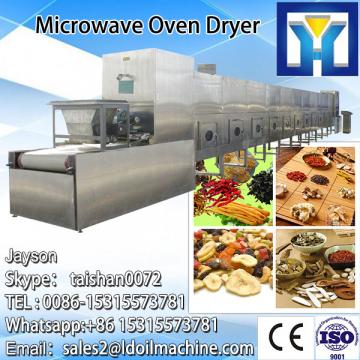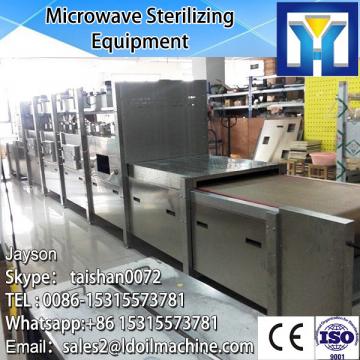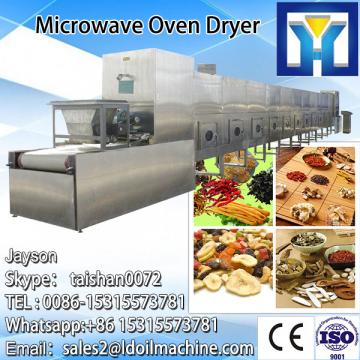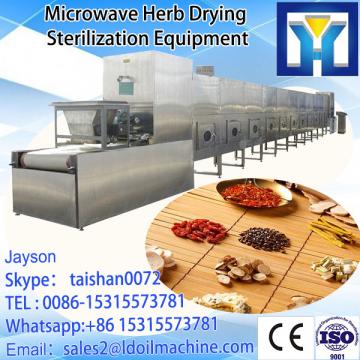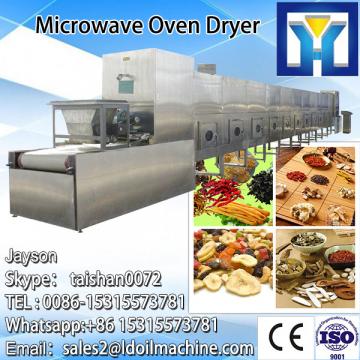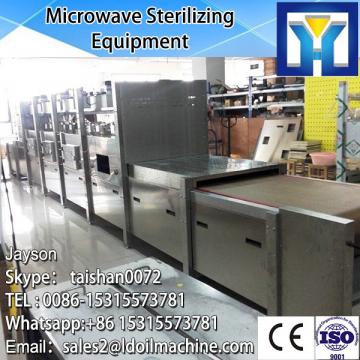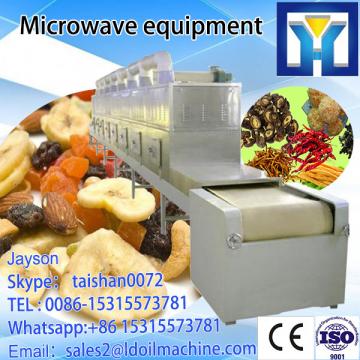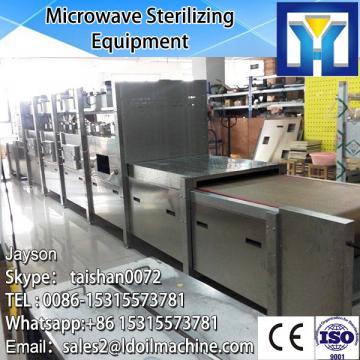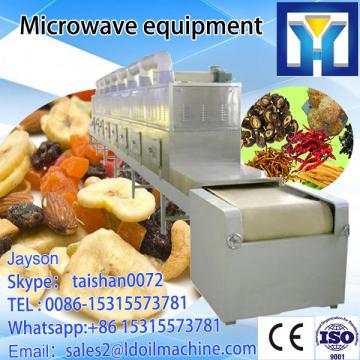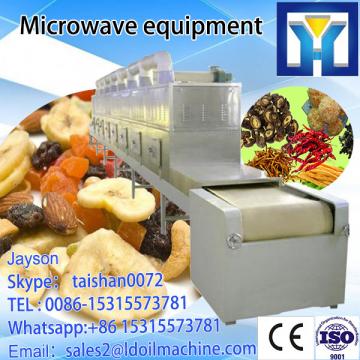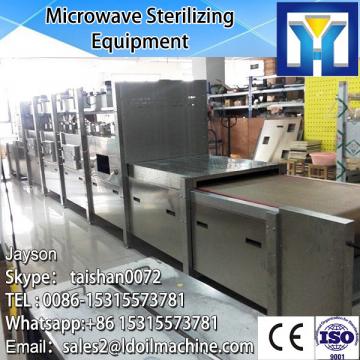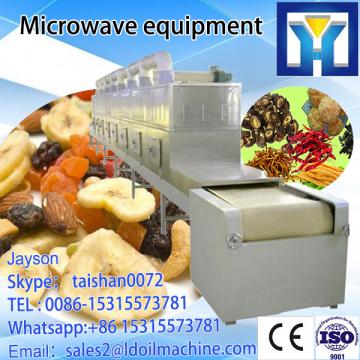
- Oil Expeller, Oil Press and Oil Refinery Machine Supplier
- ----------Shandong Leader Machinery Co.,ltd.
- AddressNo.15, Lanxiang Road, Tianqiao District, Ji'nan, Shandong, China
- Factory AddressWest Of Jiyang Road,Rencheng Dist., Jinan, Shandong, China
- Worktime9:00-18:00
- Phone(Working Time)86-0531-85064681
- Phone(Nonworking Time)86-0531-85064681
- Fax86-0531-85064682
Chemical Material Drying Sterilization Equipment
Contact NowThe microwave is an electromagnetic wave having a wavelength of 1-1000 mm and a frequency of 0.3-300 GHz. In order to standardize the field of microwave applications and avoid mutual interference, the international conventions specify the following frequencies: (915 ± 25) MHz, (2450 ± 13) MHz, (5800 ± 75) MHz, (22125 ± 125) MHz for industrial, civil and Heating and drying in scientific research. Among them, 2450 MHz is equivalent to a microwave with a wavelength of 12. 2 cm, which is the most widely used frequency. Since the end of the 19th century, Hertz has confirmed the existence of electromagnetic waves. Since the American scientist Worth confirmed in 1936 that electromagnetic waves could be transmitted in hollow metal tubes, microwave technology has been continuously developed and widely used. Currently, Chemical Material Drying Sterilization Equipment has been used in materials, waste treatment, electronics, food processing, chemicals, pharmaceuticals, environmental protection, family life and military. Chemical Material Drying Sterilization Equipment in Organic
Research status in the fields of synthesis, material synthesis, sample analysis, and wastewater treatment.
1 Chemical Material Drying Sterilization Equipment
1. 1 Microwave technology for organic synthesis Microwave irradiation (MWI) was first used in organic synthesis reactions in the 1960s using electromagnetic radiation pulses for emulsion polymerization of acrylate, acrylic acid and methacrylic acid. The beginning of the application of MWI technology in organic synthesis began with Canadian scholar Gedye et al. [1]. In 1986, they discovered that the nucleophilic substitution reaction of 4-cyanophenoxy ion with benzyl chloride under microwave irradiation in 1986 can make The reaction rate is increased by 1240 times, and the yield is also increased to varying degrees. This discovery caused the pole of the chemical industry
Great interest. Since then, in just over a decade, research on the promotion of organic chemical reactions by microwave radiation has become a hot spot in the field of organic chemistry, and has gradually formed a compelling new field - Microwave-Induced or Microwave -Assisted organic syntheses.
1. 1. 1 Microwave-promoted (assisted) organic reaction mechanism Generally, there are two kinds of microwave-promoting (assisted) organic reaction mechanisms: (1) Pyrogenic effect: Compared with traditional heating reaction, microwave heating is fast, uniform, and temperature-free. Gradient, no hysteresis. Microwaves allow the solvent to be superheated instantaneously, allowing the liquid to reach higher temperatures before boiling. The acceleration of the chemical reaction by microwaves is mainly attributed to the selective heating of polar organic compounds, that is, the pyrogenic effect of microwaves. G-LEADER studied the hydrolysis reaction of adenosine triphosphate (AT P) under the action of microwave. It was found that the reaction speed under microwave was 25 times that of conventional heating, but there was no significant change in reaction kinetics under the two heating modes. In 1992, Raner et al. [3] studied the effect of microwave on the esterification rate of 2,4,6-trimethylbenzoic acid and 2-propanol. The results also showed that the final esterification yield was only related to temperature. Related, regardless of the heating method.
(2) Non-pyrogenic effect: Microwave not only makes the reactant molecules move vigorously, the temperature rises, but also the Lorentz force of the ions on the ions and polar molecules makes the relative motion between these particles special, and there is a non-heating effect. . Domestic yellow Kama et al [4] found that the electromagnetic wave does change the activation energy and pre-exponential factor of the reaction by studying the reaction kinetics of KI and H2O2, and this change is related to temperature, and the activation energy and the change of the pre-exponential factor make the reaction The results of acceleration and deceleration are presented. The experiment also proves that microwave can inhibit the progress of chemical reaction under certain conditions.
1. 1. 2 Microwave organic synthesis reaction technology Unlike general organic reactions, microwave reactions require specific equipment and reaction techniques.
Chemical Material Drying Sterilization Equipment There are three main types of organic synthesis reaction technology:
(1) Microwave tight closure into technology.
G-LEADER's research into the introduction of microwaves into organic synthesis is based on closed synthesis. The microwave closed closure reaction technique refers to a process in which a sealed reactor containing a reactant is placed in a microwave source to start a microwave, and after the reaction is completed, the reactor is cooled to room temperature and the product is purified. This is actually a technique for reacting at relatively high temperatures and pressures. The reaction technology is characterized in that the reaction system instantaneously obtains high temperature and high pressure and greatly increases the reaction speed, but the disadvantage is that the reaction vessel is easily deformed or burst.
(2) Microwave atmospheric pressure synthesis technology. In order to carry out the microwave atmospheric organic synthesis reaction under safe conditions, Baghurst [5] modified the domestic microwave oven, opened a small hole in the furnace wall, placed the condenser tube outside the microwave cavity, and filled the solution with a round bottom flask. The glass joint is connected to the air condensing pipe, and the latter is connected to the outer water condensing pipe through a copper pipe riveted to the microwave oven side. When the microwave is rapidly heated, the solution
Safe return in the device. Next, a Teflon tube is connected to the reaction vessel through which an inert gas is supplied to the reaction vessel to protect the reaction system. In the experimental device designed by the system, since the system has no stirring, dropping and water dividing device, it often causes great trouble to the reaction and limits the application range of the device.
G-LEADER has improved the atmospheric system by punching holes in the upper end of the microwave oven. The reaction vessel is connected to the external agitation and dropping device and the condenser tube from the perforation. This device performs a microwave organic reaction under normal pressure, and is equipped with a stirring, dropping and water dividing device. Compared with the closed technology, the device used in the atmospheric pressure technology is simple, convenient and safe, and is suitable for most microwave organic reactions.
(3) Continuous Chemical Material Drying Sterilization Equipment technology. The g-leader establishes continuous microwave technology, which consists of four parts. The reactants are pressurized into the microwave oven through the pump body, and are radiated into the furnace and then flowed out into the receiver. The shortcomings of the device for microwave reaction are obvious. First, the device cannot measure temperature; secondly, there is no pressure reducing device at the exit of the sample, making reception difficult. Since then, a series of new practical and safe microwave continuous synthesis reaction technologies have been developed.
1. 1. 3 Microwave-promoted (auxiliary) organic reaction type The organic reaction rate under microwave irradiation (MWI) is several times or even thousands of times faster than the traditional heating method, and can be used under some conventional reflow conditions. A reaction that cannot be activated and cannot be carried out or is difficult to carry out, and has simple operation, short time, high yield, low or no catalyst, low consumption of reaction solvent or vehicle, easy recovery, high purity, short synthetic route, etc. Features, so microwaves are widely used in organic synthesis and rapidly developed. The types of reactions involved in microwave chemistry nowadays [8-15] include esterification, Diels-A lder, rearrangement, Knoevenagel, Perkin, Witting, Reformatsky, benzoin condensation, Deckman, aldol condensation, ring opening, alkylation, Hydrolysis, olefin addition, elimination, substitution, free radical, stereoselective, ring formation, ring reversal, transesterification, ester amination, catalytic hydrogenation, decarboxylation, etc. and synthesis of saccharides, organometallics, radiopharmaceuticals, etc. .
1. 2 Microwave technology for material synthesis At present, microwave methods for synthesizing chemical materials mainly include microwave homogeneous phase precipitation method, microwave coprecipitation method, microwave hydrothermal method, microwave sintering method and microwave solid phase synthesis method. The olivine-type lithium iron phosphate (LiFePO4) is an emerging and promising cathode material for lithium-ion batteries with a high theoretical specific capacity (170 mAh/g) and a moderate voltage platform (3.4 V). Left and right), excellent cycle performance, low price, good safety and environmental protection have received wide attention. G-LEADER synthesized the lithium ion battery cathode material LiFePO4/C by coprecipitation-microwave method with organic surfactant polyethylene glycol (PEG) as the carbon source, and discussed the effect of microwave sintering time on the structure and properties of the sample. The results show that: microwave sintering
The 9 min sample has a single olivine crystal structure and good electrochemical performance. At room temperature, it is charged and discharged with 0.1 C, 0.2 C and 1 C, and the first discharge specific capacity reaches 154. , 139. 7 and 123.5 mAh/g, after 15 cycles, remained at 152.3, 134.3 and 118. 5 mAh/g. The synthesis of LiFePO4/C positive electrode material by microwave method can significantly shorten the synthesis cycle and save energy compared with the conventional sintering method. Cadmium sulfide is an important semiconductor material with a wide range of applications in solar energy conversion, non-linear optics, photoelectrochemical cells and photocatalysis.
G-LEADER prepared relatively uniform particle size CdS nanoparticles by microwave solidification, and studied the effects of microwave heating and non-heating, reaction time and reaction time interval on the preparation of CdS nanoparticles. Experiments show that pure CdS nanoparticles can not be obtained by grinding only, and pure CdS nanoparticles can be obtained after microwave heating. The reaction time is 60 s, the particles are spherical, the dispersion is uniform, and the particle size distribution is narrow. The diameter is 4. 9 nm; the use of microwave continuous heating for a longer period of time is beneficial to the formation of hexagonal phase cadmium sulfide, because most sulfides have a higher dielectric constant in the microwave frequency range, and have a faster heating rate. And the cubic phase cadmium sulfide can be changed into a hexagonal phase by heating. The long afterglow material is capable of storing the energy of external light irradiation, and then slowly releasing the stored energy in the form of visible light at a certain temperature (referring to room temperature). The rare earth element doped sulfur oxide is an important long Afterglow material. At present, rare earth sulfur oxides are mainly synthesized by high temperature solid phase method, and the synthesis temperature is 900 to 1300 °C. The product has a large particle size and needs to be ground for further use. For this reason, people have been working on a synthesis method which is low in temperature, small in particle size, and does not require grinding.
G-LEADER synthesized the nanocrystalline long-lasting luminescent material Y2O2S : Eu3+, Mg, Ti by hydrothermal-microwave method. It was characterized by XRD, T EM and fluorescence spectroscopy. The synthesized nanocrystalline long afterglow luminescent material Y2O2S : Eu3+,Mg, The Ti particles are single-phase hexagonal crystals. The crystal grains are small and concentrated, with a size distribution of 30-80 nm. The emission spectra are mainly at wavelengths of 469, 496, 513, 539, 555, 586, 594, 615, 625 and 703 nm. The narrow-band emission peaks are composed of 5D2 ※ 7F0 , 5D2 ※ 7F2 , 5D2 ※ 7F3 , 5D2 * 7F4 , 5D1 * 7F2 , 5D1 * 7F3 , 5D0 * 7F1 , 5D0 * 7F2 , 5 D0 * 7 F4 energy level transition The 4f~4f characteristic emission of Eu3+ ions is red in color. The phosphor powder exhibits long-lasting bright afterglow emission after being excited by ultraviolet or visible light, and has good stability.
1. 3 microwave technology for sample analysis
1. 3. 1 Microwave drying Microwave drying is an internal heating method. In the microwave drying process, the wet material is in the microwave high-frequency electric field with extremely short oscillation period, and the water molecules rapidly change with the direction of the high-frequency alternating electric field. Rotation, and severe collision and friction, a part of the microwave energy is converted into molecular kinetic energy, and expressed in the form of heat, so that the temperature of the water rises and leaves the material, thereby achieving the drying effect. That is, after the microwave enters the dried material and is absorbed, its energy is converted into heat energy inside the material dielectric. Therefore, microwave drying is the use of electromagnetic waves as a heating source, and the material to be dried itself is a heating method of the heating element. Microwave drying has the unique advantages of fast drying speed, short time, high thermal stability, good heating uniformity, high product quality and sterilization and insecticide. In order to make better use of microwave drying and the characteristics of existing drying technologies, microwave hot air drying and microwave vacuum drying have been studied [19]. Microwave drying technology has been successfully used in the fields of medicine, food industry, agriculture, chemicals, minerals, ceramics, tobacco and wood processing.
1. 3. 2 Microwave digestion Microwave-assisted acid digestion method is to use the polar molecules in the mixture of acid and sample to perform the polarity change movement under the action of microwave electromagnetic field, thereby generating the vibration, tear and interaction between the particles. Mutual friction, collision and rapid generation of a large amount of heat, while promoting better contact and reaction between the acid and the sample. Another important feature is that the water and acid in contact with the heated sample can produce much higher thermal energy than the surface of the sample, resulting in strong thermal convection, which will agitate and remove the dissolved surface of the sample particles. The inactive surface layer continually renews the contact surface of the sample with the acid, which accelerates the rapid dissolution of the sample. Microwave digestion has been widely used in the processing of samples such as geology, minerals, biology, cosmetics, food, environmental protection, analytical and synthetic materials.
G-LEADER uses a closed microwave to digest the milk powder sample to optimize the microwave digestion conditions. The experimental results show that the relative standard deviation (RSD%) of copper in milk powder is determined by microwave digestion-DDTC method. The relative standard deviation (RSD%) is 0.53%, and the recovery rate is 98. 00%~ 100.46%. The method is simple, rapid and accurate. It has strong applicability and can be used for rapid analysis of copper content in milk and dairy products.
1. 3. 3 Microwave extraction Microwave extraction is the use of microwave heating characteristics of microwave energy applications
